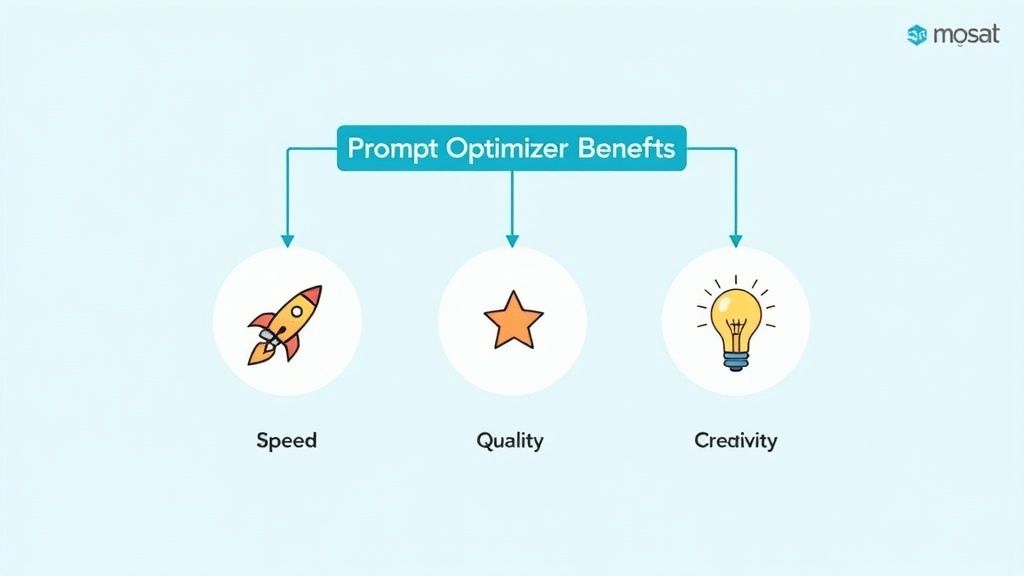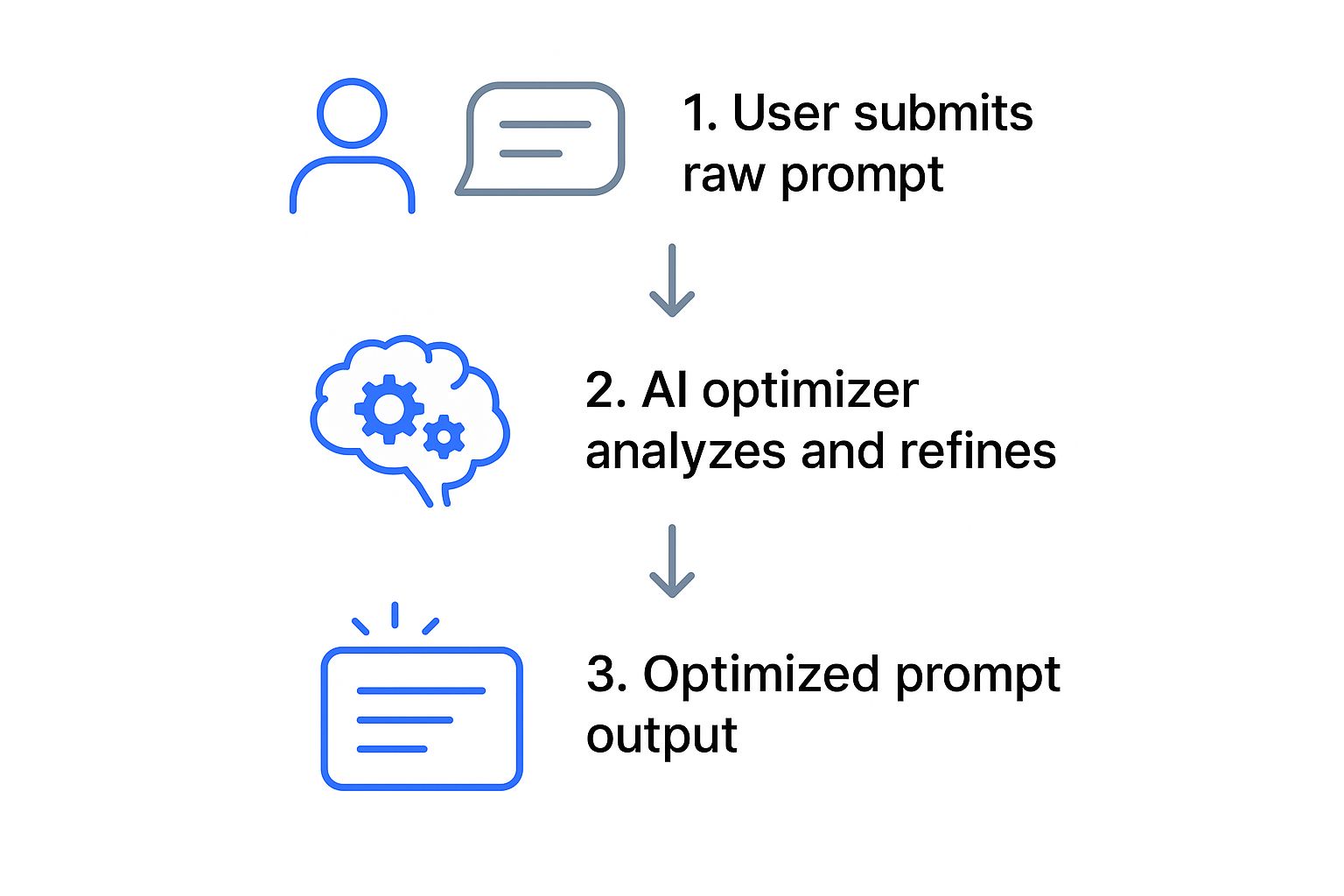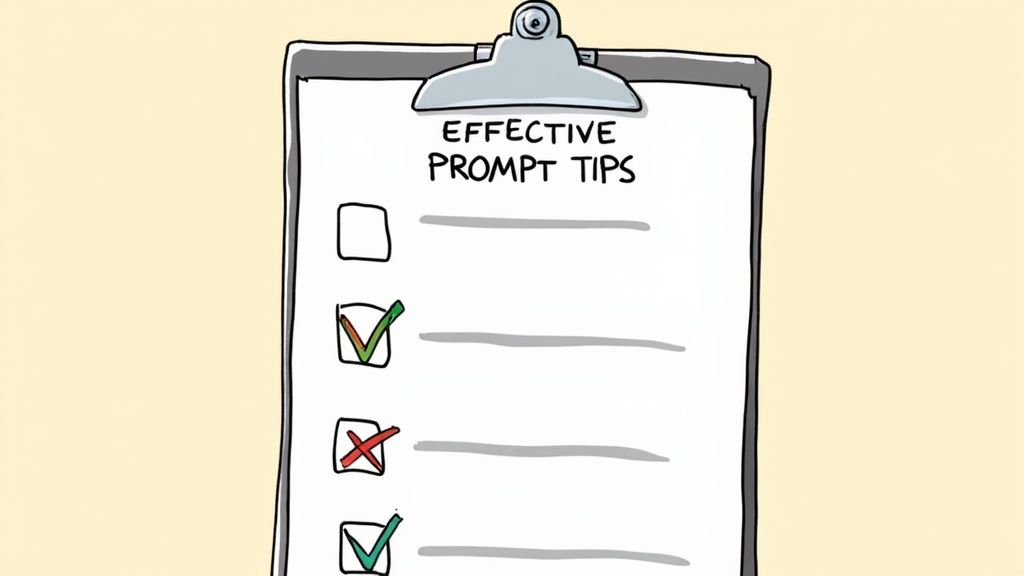Boost Results with AI Prompt Optimizer: Proven Strategies

Ever felt like you're just guessing when you write a prompt for an AI? You have a clear idea in your head, but what you get back is... well, not it. An AI prompt optimizer is designed to fix exactly that. Think of it as a tool that translates your initial thoughts into the precise, detailed language an AI needs to deliver great results every single time. It's what stops the endless cycle of rewriting and re-running your prompts.
Why An AI Prompt Optimizer Is No Longer a “Nice-To-Have”

We've all been there. You ask for a creative marketing slogan and get something that sounds like it was written by a 1980s computer. The inconsistency is frustrating and a huge time sink. This is where most people get stuck, and it’s the bottleneck that keeps them from getting real value out of AI.
A good AI prompt optimizer gives you a structured way to build better instructions. Instead of just throwing ideas at the wall and hoping something sticks, you get a repeatable framework for success. This small shift moves you from being a casual user to someone who can confidently direct the AI to produce exactly what you need.
Solving the Everyday Headaches of AI Prompting
If you're not using a systematic approach, you're probably running into the same frustrating issues over and over. An optimizer is built to tackle these problems head-on by adding the layers of detail and context that are so easy to miss when you're writing prompts manually.
Here are the common pain points an optimizer helps you solve:
- Wildly Inconsistent Outputs: It helps you lock in the variables so the same prompt doesn’t give you three completely different results on three different attempts.
- Bland, Generic Content: You can easily bake in specifics like tone of voice, target audience, and desired format, which is the secret to avoiding those one-size-fits-all AI responses.
- Wasted Hours and Rework: It cuts down dramatically on the time you spend tweaking a prompt, hoping the next run will finally be the one.
The real magic of an optimizer is that it turns prompt creation from a frustrating art form into a repeatable science. You're building a reliable system to communicate exactly what you want, ensuring the AI’s output lines up perfectly with your goals.
This isn't just a clever workflow hack; it's becoming a fundamental business skill. The market for prompt engineering is exploding—it was valued at USD 380.12 billion in 2024 and is expected to hit over USD 6.5 trillion by 2034. You can dig into the numbers behind this incredible growth in a recent market analysis from Precedence Research.
This table breaks down the practical difference between going it alone and using a dedicated tool.
Manual Prompting vs Optimized Prompting
| Challenge | Manual Approach (Without Optimizer) | Strategic Solution (With Optimizer) |
|---|---|---|
| Inconsistent Results | Hope for the best with each run; results vary widely. | Create structured templates that produce predictable outputs every time. |
| Vague Instructions | "Write a blog post about marketing." | Define persona, tone, audience, format, and keywords for a targeted result. |
| Time Sink | Hours spent tweaking minor words and re-running prompts. | Refine a prompt once, save it, and reuse it instantly for future tasks. |
| Lack of Scalability | Every new task starts from scratch; knowledge is lost. | Build a central library of proven prompts for the entire team to use. |
Ultimately, a good optimizer is more than just a tool—it's a system for turning your prompting efforts into a lasting asset.
From Guesswork to a Repeatable Process
When you use a tool like Promptaa to refine and save your instructions, you're not just getting a better result today. You're building a powerful, reusable library of prompts that will make every future interaction with AI faster and more effective. It's a fundamental change to your workflow.
If you want to get a better handle on the core concepts behind this, our https://promptaa.com/blog/a-guide-to-ai-prompts-engineering is a great place to start.
Building Your Foundational Prompt Library
The first real step toward getting consistently great results from AI is to stop treating your prompts like throwaway notes. It's time to build a real library—a single, organized home for your best instructions. If your go-to prompts are buried in old chat threads, random documents, or a messy spreadsheet, you're constantly reinventing the wheel.
This doesn't have to be some massive project. Just start small.
Pull together your 10-15 most-used prompts. These are the workhorses you rely on every day, whether it's for drafting emails, brainstorming blog topics, or summarizing meeting notes. The immediate goal is simple: get them out of their digital hiding spots and into one clean, structured space.
Why Smart Categorization Is a Game Changer
Okay, so just dumping all your prompts into one giant folder isn't the answer. The real magic happens when you start categorizing them intelligently. Think of it less like a junk drawer and more like a well-organized toolbox where you can instantly grab the exact tool you need for the job.
Create folders that actually reflect how you work. For instance, if you're a content marketer, your setup might look something like this:
- Blog Post Ideation: Prompts for generating topics, outlines, and killer headlines.
- Social Media Copy: Specific prompts tailored for LinkedIn, Twitter, and Instagram.
- Email Marketing Campaigns: Instructions for nailing subject lines, body copy, and CTAs.
- SEO Keyword Analysis: Prompts for finding keyword clusters and understanding search intent.
This kind of organization does more than just save you a few minutes here and there. It creates a system that can grow with you, allowing you to find, tweak, and improve your prompts without starting from scratch every single time. When you start treating your prompt library like a core business asset, your entire workflow becomes dramatically more efficient.
Actionable Tips for a High-Functioning Library
A well-organized library is the bedrock of using any ai prompt optimizer effectively. Vague file names and a messy structure completely defeat the purpose.
The objective is to make any prompt findable in under five seconds. A descriptive naming convention is your best strategy for achieving this speed and efficiency.
Instead of a generic name like "Marketing Email," get specific. Try something like "Q3 Product Launch - Teaser Email - Witty Tone." Right away, you know its purpose, the campaign it belongs to, and the voice it should have. Adding this level of detail upfront turns your library into a powerful, self-documenting system. If you want to dive deeper into structuring your actual instructions, our guide on the different types of prompting techniques is a great resource.
I know this initial setup can feel a bit like an admin chore, but trust me, it’s a strategic investment. You’re laying the foundation for all the advanced optimization that comes next, turning a collection of scattered ideas into a powerful, reusable resource that only gets more valuable over time.
Using AI to Give Your Prompts Surgical Precision

The image above really gets to the heart of what a great AI enhancement feature does. It takes a simple idea and methodically adds the layers of context and detail the AI needs to do its best work. This is how you go from a vague wish to a surgical instruction that gives you predictable, high-quality results every time.
Now that you've got a solid foundation with your prompt library, it's time for the fun part: using AI to sharpen your prompts. Think of it as having an expert prompt engineer on call, ready to look over your shoulder and polish your ideas. A good AI enhancement feature is like an intelligent co-pilot, analyzing your initial request and pointing out exactly what’s missing.
We've all been there. You type in a common, vague prompt like, "Write an ad for our new shoe." And what do you get back? Something so generic it's practically useless. That’s because the AI is forced to make a thousand assumptions about your target audience, the shoe's unique features, and what you actually want people to do after reading the ad.
From Vague Idea to Precise Command
This is where a dedicated AI prompt optimizer with an "Enhance" function changes the game. It’s smart enough to spot those gaps instantly. Instead of just guessing, it prompts you for the missing pieces. That back-and-forth is the key to turning a fuzzy concept into a laser-focused command.
Let’s see how that vague shoe ad prompt gets a complete makeover.
- Who are we talking to? The tool will suggest you stop trying to talk to everyone and focus on a specific persona, like "millennial urban explorers."
- What makes this shoe special? It will push you to include the unique selling points, maybe suggesting you add details like "all-day comfort and water-resistant material."
- How should it sound? Rather than a bland, corporate tone, it helps you define a voice, like "adventurous and witty," that will actually connect with your audience.
- What's the goal? It makes sure your prompt has a clear purpose, such as to "drive pre-orders with a limited-time discount code."
This kind of detailed refinement is exactly why businesses are pouring money into this space. The prompt engineering market in North America is exploding, with the U.S. segment alone valued at USD 108.76 million in 2024 and expected to hit USD 144.87 million by 2025. Holding a 35.8% market share, North America clearly gets that the secret to unlocking AI's true potential lies in perfecting how we talk to it. You can dig into the numbers in this comprehensive market report.
The Real-World Impact of Enhanced Prompts
By layering in these specifics, you're doing more than just writing a better prompt—you're dramatically lowering the odds of the AI spitting out something irrelevant or unusable. This level of precision is a massive help in fighting common AI errors. If you're running into those issues, our guide offers some great, practical tips on how to reduce hallucinations in LLMs.
An enhanced prompt gives the AI a clear roadmap. It eliminates ambiguity and forces the model to generate content that aligns with your specific strategic goals, rather than just giving you a technically correct but creatively bland response.
After this process, our prompt looks less like a simple request and more like a professional creative brief. The AI is no longer just a content generator; it's a creative partner executing a well-defined strategy.
Mastering Advanced Prompt Optimization Techniques
Once you’ve got the hang of basic enhancements, it’s time to really unlock what generative AI can do. This is where you move from just asking questions to actually architecting the AI's response. By mastering a few advanced techniques, you can guide its reasoning, teach it specific formats, and build versatile templates that will save you a ton of time.
These aren't just niche tricks anymore; they're becoming essential for anyone serious about getting high-quality, predictable results from AI. The money flowing into this space tells the same story. In 2024 alone, global private investment in generative AI hit a staggering $33.9 billion, which is an 18.7% jump from the year before. You can dive deeper into these investment trends and the AI toolkit landscape from Baytech Consulting. That kind of cash doesn't lie—it shows just how valuable it is to learn how to communicate effectively with these models.
Guide the AI with Chain-of-Thought Prompting
One of the most powerful methods for complex problems is Chain-of-Thought (CoT) prompting. The idea is simple but incredibly effective: instead of just asking for a final answer, you tell the AI to "think step by step" and show its work.
This simple instruction forces the model to break down a big, complicated task into a series of smaller, logical steps. It’s like showing your work in a math class. If you just ask for the answer to a tough equation, the AI might stumble. But if you ask it to outline each calculation along the way, its chances of getting the right answer go way up.
Let's apply this to a real business scenario.
- A weak prompt might be: "Analyze our Q3 sales data and suggest a marketing strategy." This is too broad and invites a generic, unhelpful response.
- A CoT prompt is much better: "First, analyze the attached Q3 sales data to identify our top three best-selling products. Second, figure out the primary customer demographic for those products. Third, based on that demographic, brainstorm three distinct marketing campaign ideas, complete with a key message for each."
This structured approach doesn't leave room for the AI to make weird logical jumps. It guides the model toward a much more thoughtful and well-reasoned output.
Teach the AI Your Style with Few-Shot Learning
Few-Shot Learning is like giving the AI a mini-training session right inside your prompt. You're not just telling it what you want; you're showing it with a few perfect examples. This is my go-to technique for tasks that need a very specific structure, tone, or format.
Imagine you're trying to generate product descriptions for your e-commerce store and you need them all to follow the same formula.
By providing 2-3 examples of your ideal output, you are showing the AI your exact expectations rather than just telling it. This is one of the fastest ways to achieve format consistency and nail a specific brand voice.
Here’s what that looks like in practice:
Prompt: I need product descriptions. Here are some examples:
Example 1: Input: Hiking Boots Output: **Rugged Trailblazer Boots:** Built for adventure. Features waterproof leather, ankle support, and high-traction soles.
Example 2: Input: Yoga Mat Output: **ZenFlow Yoga Mat:** Find your balance. Made from eco-friendly cork with a non-slip grip.
Now, generate one for this input: Input: Running Shorts
The AI will immediately pick up on your pattern and deliver a description that's perfectly formatted, without you having to write a long, convoluted list of instructions.
Create Scalable Templates with Variables
Ready for the ultimate efficiency hack? Turn your best prompts into reusable templates by using variables or placeholders. This lets you take a single, expertly crafted "master prompt" and adapt it for dozens of different situations with almost no effort.
A good ai prompt optimizer like Promptaa makes managing a library of these templates dead simple.
For example, think about a master prompt for handling customer support emails:
"Draft a polite and empathetic response to a customer regarding their issue with [Product Name]. Their specific problem is [Customer Issue]. Offer [Proposed Solution] and end with a positive closing."
Now, for every new support ticket, you just plug in the details for the bracketed variables. This ensures every single response is consistent, on-brand, and high-quality, saving your team from reinventing the wheel every time.
Weaving Prompt Optimization into Your Daily Work
The real magic happens when prompt optimization stops being a chore and becomes a natural part of how you work. Think of it less like a one-off task and more like a simple, repeatable habit. By building a solid workflow, you'll avoid that frustrating feeling of starting from scratch every time an AI doesn't quite get what you mean.
This is how you turn a rough idea into a polished, reusable asset that works for you again and again.

This visual really captures the core idea of an ai prompt optimizer. It’s about taking a simple request, letting a smart engine refine it, and ending up with a set of instructions the AI can actually work with effectively.
Think Like a Sculptor, Not a Demolition Crew
The most important shift you can make is in your mindset. When a generative AI gives you a response that’s a little off, don't throw the whole prompt away. Your first instinct should be to treat it as a draft that just needs a few tweaks. This is the iterative approach, and it’s how you build a library of truly powerful prompts over time.
Let's say you asked an AI for a social media post, but the result sounded way too stuffy and formal. Instead of starting over, you'd:
- Pinpoint the problem: The instruction for tone was probably too generic. "Professional" can mean a dozen different things to an AI.
- Sharpen the instruction: Jump back into the prompt and get more specific. Swap out "professional" for something like "upbeat, witty, and conversational."
- Test and lock it in: Run the new version. If the output is spot-on, save this improved prompt to your library. You’ve just made that prompt better for every single time you use it in the future.
This cycle of continuous refinement is so much more efficient than starting from zero. In fact, research into prompt engineering has shown that making these kinds of specific, structured edits can boost effectiveness by over 20% for some tasks.
The real power of an ai prompt optimizer isn't just in making one great prompt. It's in making it incredibly easy to refine and perfect that prompt over time. Every small adjustment you make is an investment that pays off every time you hit "run."
Carve Out Time for Continuous Improvement
Building an amazing prompt library doesn't mean you need to clear your calendar. A little bit of consistency is all it takes. One of the best habits I've seen people adopt is blocking off just 15-20 minutes a week to polish their most-used prompts.
During that short session, pull up 3-5 of your go-to prompts in Promptaa. Take a look at the results they've been giving you. Could the instructions be clearer? Could you be more direct? This small, consistent effort compounds over time, ensuring your prompt library grows with you and saves you countless hours down the road.
Common Questions About Prompt Optimizers

When you first hear about a tool for improving AI prompts, a few questions usually come to mind. Is it really necessary? How does it actually work? We get it. Let's tackle some of the most common questions people have when they start exploring prompt optimization.
My goal here is to cut through the noise and give you straight answers. This way, you can see exactly how a structured approach to your prompts can make a real difference in your day-to-day work.
What Exactly Is an AI Prompt Optimizer, and Why Bother?
You can absolutely write all your prompts by hand. But an ai prompt optimizer is designed to take that manual process and make it smarter and more systematic. Think of it less as a crutch and more as an expert partner. It spots where your instructions might be vague, suggests adding critical details like tone or context, and gives you a central place to save and reuse the prompts that work.
It’s all about shifting from a "let's see what happens" approach to a repeatable, strategic process. The real payoff? You save a massive amount of time by cutting out the endless cycle of trial-and-error.
Who Really Needs a Prompt Tool?
While anyone using AI can get something out of it, these tools are a game-changer for specific roles where consistency and quality are non-negotiable.
- Marketers and Content Creators: It's perfect for keeping a consistent brand voice across campaigns and scaling up content creation without sacrificing quality.
- Developers and Engineers: When you need reliable code snippets or technical documentation, a well-tuned prompt is your best friend.
- Researchers and Analysts: These tools help you structure complex queries so you can get the exact data analysis or summary you need, the first time.
Basically, if your job relies on getting predictable, high-quality results from an AI, a prompt optimizer should be a core part of your toolkit.
An optimizer is a powerful aid, not a replacement for understanding. It significantly lowers the barrier to entry and helps you create better prompts immediately. Using the tool will naturally teach you the principles of good prompt engineering.
How Do I Start Optimizing My Prompts?
Getting started is much simpler than you might think. You don’t need to be a prompt engineering wizard. The best way is to start with what you already have.
- Grab Your Go-To Prompts: First, just pull together your 5-10 most-used prompts. Don't overthink it.
- Give Them a Home: Import them into your optimizer and create some simple folders that make sense to you, like 'Email Campaigns' or 'Blog Ideas'.
- Enhance and See What Happens: Pick one prompt and use a feature like 'Enhance' to see what the AI suggests. It might add a persona, request a specific format, or clarify the goal.
- Test, Tweak, and Save: Apply the suggested changes, run the new prompt to see the difference, and save that winning version back into your library.
This isn't about a massive, one-time overhaul. It's about making small, consistent improvements that add up over time, building an incredibly valuable personal asset along the way.
Ready to stop guessing and start directing? Promptaa gives you the tools to build, refine, and manage a powerful library of AI prompts. Transform your workflow and get the high-quality results you need, every single time. Start organizing your prompts for free at Promptaa.